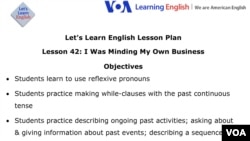Let's Learn English (Tiếng Anh cơ bản) là một khóa học tiếng Anh mới. Các giáo viên dạy tiếng Anh-Mỹ đã soạn thảo khóa học này cho những người mới bắt đầu. Khóa học sẽ kéo dài trong 52 tuần.
Mỗi tuần sẽ có một bài học mới bằng video cho thấy cuộc sống của giới trẻ Mỹ. Bài học giúp trau dồi kỹ năng nói, viết và từ vựng.
Ngoài ra cũng sẽ có các bài thực hành có thể in ra, bảng đánh giá và kế hoạch học tập cho cá nhân và giáo viên dạy tiếng Anh. Chúng tôi khuyến khích các bạn theo dõi các bài học hàng tuần và chia sẻ sự tiến bộ của bạn với chúng tôi qua phần ý kiến và email.
Tóm lược (Summary)
Anna sees a crime and tries to help find the robbers. She hurts her arm. The news reporter wants to know, "How did she hurt herself?"
Anna nhìn thấy một vụ án xảy ra và cố gắng đuổi theo kẻ cướp. Cô ấy bị thương ở tay. Phóng viên muốn tìm hiểu vì sao tay cô ấy lại bị thương.
Nói (Speaking)
In this video, learn how to say the new words. Then learn how to use reflexive pronouns like herself, ourselves, and yourself.
Cách phát âm (Pronunciation)
Use this video to understand how English speakers pronounce the words "did you" quickly and learn to say them as /didjə/.
Phần đối thoại (Conversation)
Guy: Hello. I'm Guy Newsman with News Channel XYZ. I’m here in Washington, D.C. at the scene of a crime.
Viết (Writing)
In this lesson, Anna hurt herself in the vending machine. Did you ever hurt yourself by accident? What were you doing when you hurt yourself? Write to us by email or in the Comments section.
Click on the image below to download the Activity Sheet and practice writing and using the past continuous tense and reflexive pronouns.
Sách lược học tập (Learning Strategy)
Learning Strategies are the thoughts and actions that help make learning easier or more effective.
The learning strategy for this lesson is Read Between the Lines. This expression means to find a hidden meaning in something said or written.
In this lesson, Guy Newsman asks Anna many questions. Anna tells him a long story about the crime. But she doesn't explain how she hurt her arm until the end. Guy reads between the lines each time he guesses about how she hurt her arm.
Do you ever read between the lines to understand what you hear or read in English? Write to us about it in the Comments section or send us an email. Teachers, see the Lesson Plan for more details on teaching this strategy.
Bài kiểm tra (Quiz)
Listen to short videos and test your listening skills with this quiz.
______________________________________________________________
Từ ngữ mới (New Words)
|
Subject Pronouns (Lesson 2) |
Object Pronouns (Lesson 18) |
Possessive Adjectives (Lesson 15) |
Possessive Pronouns (Lesson 37) |
Reflexive Pronouns (Lesson 42) | |
|
1st person |
I |
me |
my |
mine |
myself |
|
2nd person |
you |
you |
your |
yours |
yourself |
|
3rd person (female) |
she |
her |
her |
hers |
herself |
|
3rd person (male) |
he |
him |
his |
his |
himself |
|
3rd person (neutral) |
it |
it |
its |
(not used) |
itself |
|
1st person (plural) |
we |
us |
our |
ours |
ourselves |
|
2nd person (plural) |
you |
you |
your |
yours |
yourselves |
|
3rd person (plural) |
they |
them |
their |
theirs |
themselves |
______________________________________________________________
Tài liệu miễn phí (Free Materials)
Download the VOA Learning English Word Book for a dictionary of the words we use on this website.
Each Let's Learn English lesson has an Activity Sheet for extra practice on your own or in the classroom. In this lesson, you can use it to practice using the past continuous tense and reflexive pronouns.
Phần dành cho giáo viên (For Teachers)
See the Lesson Plan for this lesson for ideas and more teaching resources. Send us an email if you have comments on this course or questions.
Grammar: Reflexive pronouns; While-clauses; Past Continuous Tense,
Topics: Describing ongoing past activities; Asking about & giving information about past events; Describing a sequence of events; Expressing concern about someone; Reacting to bad news; Expressing sympathy
Learning Strategy: Read Between the Lines
Speaking & Pronunciation: Reflexive pronouns; Pronouncing /didjə/
____________________________________________________________
Now it's your turn. Send us an email or write to us in the Comments section below or on our Facebook page to let us know what you think of this lesson.



